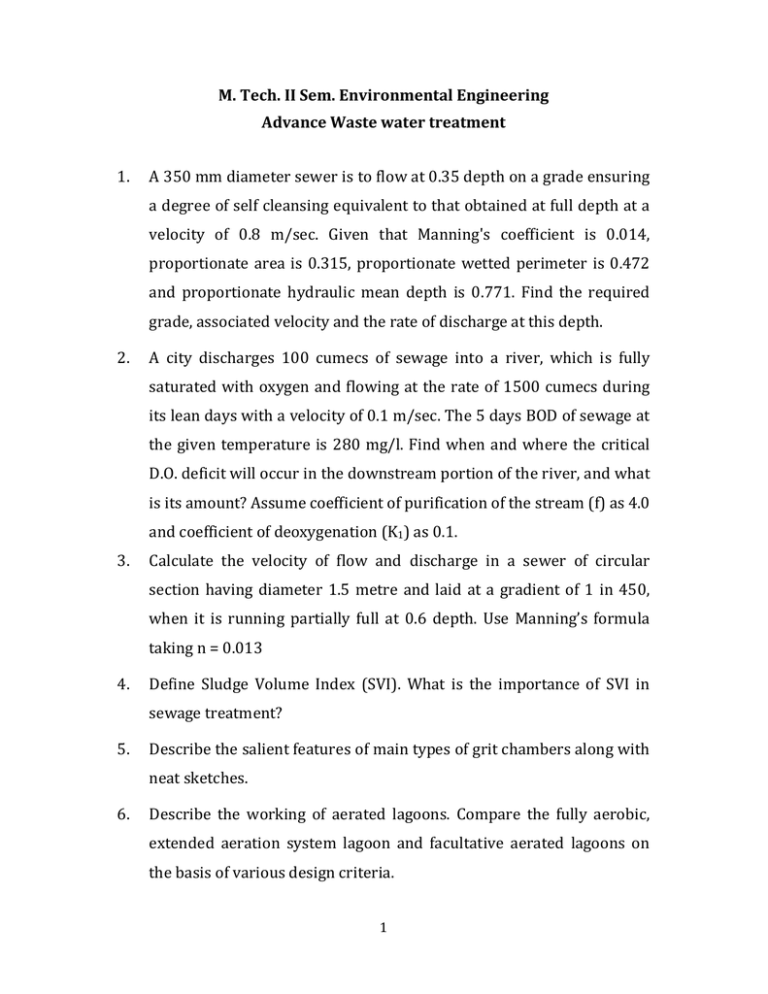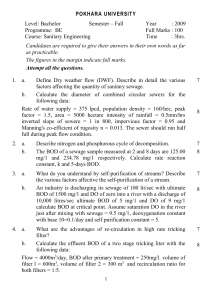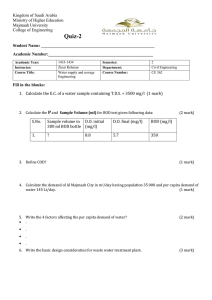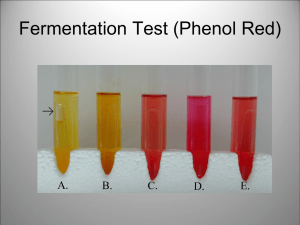assign_wastewater
advertisement

M. Tech. II Sem. Environmental Engineering Advance Waste water treatment 1. A 350 mm diameter sewer is to flow at 0.35 depth on a grade ensuring a degree of self cleansing equivalent to that obtained at full depth at a velocity of 0.8 m/sec. Given that Manning's coefficient is 0.014, proportionate area is 0.315, proportionate wetted perimeter is 0.472 and proportionate hydraulic mean depth is 0.771. Find the required grade, associated velocity and the rate of discharge at this depth. 2. A city discharges 100 cumecs of sewage into a river, which is fully saturated with oxygen and flowing at the rate of 1500 cumecs during its lean days with a velocity of 0.1 m/sec. The 5 days BOD of sewage at the given temperature is 280 mg/l. Find when and where the critical D.O. deficit will occur in the downstream portion of the river, and what is its amount? Assume coefficient of purification of the stream (f) as 4.0 and coefficient of deoxygenation (K1) as 0.1. 3. Calculate the velocity of flow and discharge in a sewer of circular section having diameter 1.5 metre and laid at a gradient of 1 in 450, when it is running partially full at 0.6 depth. Use Manning’s formula taking n = 0.013 4. Define Sludge Volume Index (SVI). What is the importance of SVI in sewage treatment? 5. Describe the salient features of main types of grit chambers along with neat sketches. 6. Describe the working of aerated lagoons. Compare the fully aerobic, extended aeration system lagoon and facultative aerated lagoons on the basis of various design criteria. 1 7. Design a septic tank for a hostel housing 250 students. Explain the working of septic tank with a neat sketch. 8. Differentiate between BOD and COD. For a waste water sample, 5-day BOD at 20o C is 200 mg/l and is 67% of ultimate BOD. What will be the 4-day BOD at 30o C? 9. Discuss advantages of recirculation of sewage in activated sludge process. 10. Discuss the comparative merits and demerits of separate system and combine system of sewerage. 11. Discuss the procedures to be followed in determining the area required for settling tank when data from series of settling tests conducted at different solids concentration are available. 12. Distinguish between Septic tank and Imhoff tank. Design a septic tank for a hostel housing 200 students. Explain the working of septic tank with a neat sketch. 13. Draw a flow diagram in schematic form of conventional wastewater treatment plant having primary and secondary treatment by conventional activated sludge and nitrogen removal by nitrificationdenitrification. Sludge treatment is by two stage anaerobic digestion. Identify each unit in the system and briefly state its purpose. State the destination of all materials leaving the plant. Identify all points of chemical addition and name the chemical. 14. Draw the biomass growth and food utilization curve and explain the following terms: Biomass, lag phase, log-growth phase, stationary phase, endogenous phase. 15. Explain in detail the process of self purification of rivers. 2 16. Explain the wastewater characteristics like pH, colour, solids, nitrogen, phosphorus, chlorides, BOD and COD along with the significance of their determination. 17. Find the relation between the sides of a square section of one sewer and diameter of circular section of another sewer when both are hydraulically equivalent. 18. For a waste water sample, 5-day BOD at 20o C is 375 mg/l and is 67% of ultimate BOD. What will be the 2-day BOD at 35o C 19. How the storm water flow computed? Explain the rational method of design of storm water sewers. Explain clearly the relation between design rainfall intensity and time of concentration. 20. Specify the qualities of a good material for constructing sewers. Judging from these requirements discuss the suitability of stoneware for sewers. 21. State the methods of collection and disposal of refuse. Explain the method you will use for rural areas. 22. State the properties of activated sludge and explain its action. Discuss the type of aeration tanks employed in the diffused air aeration. 23. The moisture content of a sludge sample was reduced from 95% to 90%. Estimate the corresponding percent volume reduction. 24. The sewage is flowing at the rate of 4.8 million liters/day from a primary clarifier to a standard rate trickling filter. The 5 day BOD of the influent is 180 mg/l. The value of organic loading may be taken as 200 gm/m3/day and surface loading rate as 1800 l/m2/day. Determine the volume of the filter and its depth. Also calculate the efficiency of this filter unit. 3 25. What do you understand by attached growth process and suspended growth process? Explain with the help of a neat sketch, the biological process involved in activated sludge process. 26. What do you understand by Digestion of sludge? Differentiate between anaerobic and aerobic digestion. Explain the mechanism of anaerobic digestion . 27. What is sludge and why it is required to be treated? Discuss in brief different methods of sludge treatment. 28. What is SVI and what is its significance? What happens if it is too high and what action would you take to prevent or correct such a situation. 29. What is the necessity of providing man-hole in a sewer line? State the locations at which manholes are provided. Sketch and explain the construction of a manhole. 30. What is the necessity of sewage treatment? Describe the role of environmental engineer in the protection of the environment. 31. What is the role of temperature in the anaerobic digestion of sludge? 32. What is the significance of loss of head consideration In the design of each treatment unit for sewage treatment? Give expression for head loss through screens and expected quantity of screenings. 33. Why are aeration devices a vital part of biological reactors? Name and describe the two major aeration techniques, indicating the kinds of biological reactors in which they are most often used. 34. Why is it necessary to provide ventilation of house drainage system? Draw a neat sketch to show the typical ventilation arrangements including inlet, outlet etc. to a house drainage system. 35. Why water seal is provided in the trap, give causes of failure of water seal and its remedial measures. 4 36. Write short notes on the following: (i) BOD sag curve (ii) Gas production by sludge digestion (iii) Grit chamber (iv) Oxidation pond (v) Oxygen sag curve (vi) Parshall flume (vii) Sewage farming (viii) Sludge drying beds (ix) Symbiosis process (x) Winkler method 37. Design an oxidation pond to treat waste water from a community of 15000 people with a B. O. D. contribution of 45 grams/capita/day. Water is supplied at a rate of 180 liters per capita per day. Determine the detention time and also whether the effluent is suitable for irrigation if 80% B. O. D. removal is achieved a) Pond’s L : W = 4:1 b) Depth of Pond =2m c) Permissible BOD < 0 mg/l for irrigation water d) Permissible BOD loading rate to oxidation pond is 200 kg/hectare/day. 38. An average operating data for conventional activated sludge process plant is as follows: (i) Waste water flow : 50000 m3/day (ii) Volume of aeration tank : 15500 m3 5 (iii) Influent BOD : 200 mg/l (iv) Effluent BOD : 25 mg/l (v) M.L.S.S. : 3000 mg/l (vi) Effluent suspended solids : 40 mg/l (vii) Waste sludge suspended solids 12000 mg/l (viii) Quantity of waste sludge : 250 m3/day (ix) : 0.8 MLVSS/MLSS Based on the above information, determine:(a) Aeration period (b) F/M ratio (c) % efficiency of BOD removal (d) Sludge age 39. What is oxygen sag curve? Draw typical oxygen sag curves for the following situations: (i) River turning septic on discharge of waste. (ii) River receiving domestic sewage having good dilution and flow. 40. Differentiate between the following:i) Aerobic and anaerobic digestion ii) Hydraulic loading and organic loading iii) Primary and Secondary sludge iv) Septic Tank and Imhoff tank v) Unit process and unit operation 6


